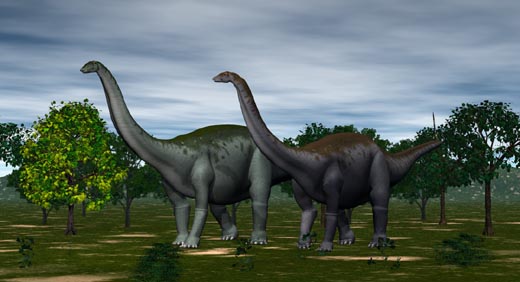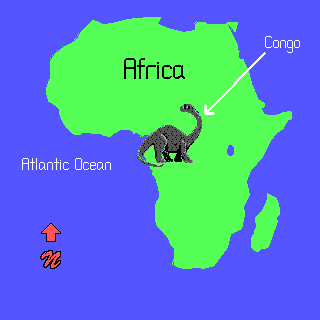pop up description layer
HOME
Cryptozoology UFO Mysteries Aviation Space & Time Dinosaurs Geology Archaeology Exploration 7 Wonders Surprising Science Troubled History Library Laboratory Attic Theater Store Index/Site Map Cyclorama
Search the Site: |
|
Dinosaurs in the Congo?
Ever since scientists identified the first dinosaur fossils, back in the 19th century, there have been stories suggesting that at least one variety of these great reptiles survived extinction and still lived in the swamps of central Africa. A few of the earliest and most colorful tales came from Alfred Aloysius Horn, a traveler, trader, and adventurer of the last century. His stories told of a creature living in the swamps and rivers. The animal was called, "Jago-Nini" which meant "giant diver." Though Horn had never seen the creature himself he was told that it, "Comes out of the water and devours people." Horn did say he'd seen a footprint that was, "about the size of a good frying pan in circumference and three claws instead o'five." Through the years a number of explorers visited Africa and heard about huge unknown reptiles. These animals went under a variety of different names including "dingonek," "Ol-umaina," and "chipekwe." In every case, though, explorers only heard stories from the natives about the animals, but never saw direct evidence of the creatures existence for themselves. An exception was when, in 1932, British cryptozoologist Ivan Sanderson was traveling in Africa and came across large hippo-like tracks in a region with no hippos. He was told by the native that they were made by a creature named the "mgbulu-eM'bembe". Later Sanderson saw something in the water that seemed too large to be a hippo, but disappeared before he could get a good look at it. To further confuse the issue several hoaxes surrounded stories of the African dinosaur. The most widespread came in 1901 when rumors that the Smithsonian Institution was looking for someone to go to central Africa and bring back a Brontosaurus (proper technical name of Apatosaurus) appeared in a London newspaper. Perhaps the best known reports about this kind of creature came out of the Congo after the turn of the century. Captain Freiheer von Stein zu Lausnitz, a German explorer, heard stories about an animal that was "brownish gray with a smooth skin, its size approximately that of an elephant, at least that of a hippopotamus." The creature had long flexible neck and had a vegetarian diet. The natives called it mok'ele-mbembe.
Shortly after Mackal's second expedition a group from California, led by Herman and Kia Regusters, reported seeing and photographing a large creature in the Lake Tel area. While the descriptions matched those heard since von Stein, the photos turned out to be inconclusive.
Copyright Lee Krystek 1996. All Rights Reserved. |
|
Related Links |
|
|




 As
more and more of Africa was charted and explored the dinosaur
tales faded away. However, in 1980, Dr. Roy Mackal, a biologist
at the University of Chicago and James Powell, a herpetologist,
decided to go and take another look at the source of the mok'ele-mbembe
tales. As with earlier explorers they failed to see the creature
themselves. However, they did interview several people who had,
and also heard about a creature with a long neck and tail that
was killed along Lake Tel in 1959. According to the story anyone
who ate of the creatures meat, died. Witnesses said mok'ele-mbembe
was about thirty feet long. Of that ten was head and neck, the
rest body and tail. Mackal and Powell suspected that the creature
was a small relative of the Apatosaurus, but gathered
no proof. A second expedition the next year added nothing but
some strange footprints.
As
more and more of Africa was charted and explored the dinosaur
tales faded away. However, in 1980, Dr. Roy Mackal, a biologist
at the University of Chicago and James Powell, a herpetologist,
decided to go and take another look at the source of the mok'ele-mbembe
tales. As with earlier explorers they failed to see the creature
themselves. However, they did interview several people who had,
and also heard about a creature with a long neck and tail that
was killed along Lake Tel in 1959. According to the story anyone
who ate of the creatures meat, died. Witnesses said mok'ele-mbembe
was about thirty feet long. Of that ten was head and neck, the
rest body and tail. Mackal and Powell suspected that the creature
was a small relative of the Apatosaurus, but gathered
no proof. A second expedition the next year added nothing but
some strange footprints.
